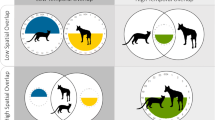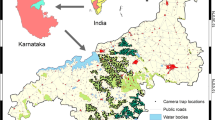Abstract
Context
Many Mediterranean ecosystems are human-dominated landscapes comprising a mosaic of agricultural, natural and semi-natural habitats alongside urban areas. The size, spatial pattern and connectivity of these “mosaic landscapes” promote changes in wildlife behavior, movement patterns and habitat use.
Objectives
Study how spatiotemporal landscape changes impact the spatial dynamics of a mammalian carnivore guild.
Methods
We quantified multi-season activity rates/density from camera trap encounters using N-mixture models. One hundred cameras were located at 25 sites, divided into five categories: nature reserve; large natural area; vineyards within natural area; vineyards near settlements; vineyards within the core agricultural matrix.
Results
Golden jackals (Canis aureus) were active in anthropogenic modified landscapes. Red foxes (Vulpes vulpes) avoided the core activity areas of jackal during summer and restricted their activity to their peripheries. European badgers (Meles meles) were active in natural patches during winter, but shifted their activity during summer to agricultural fields embedded within natural patches. Feral and wilds cats (Felis silvestris) were highly active in the natural patches during winter and shifted their activity to the agricultural matrix during summer.
Conclusion
Intra-guild spatio-temporal activity patterns of carnivores in mosaic landscapes are distinct and unique to each species. The patterns were affected by season, land-use, and jackal activity rates, reflecting inter-specific resource-dependent competitive interactions. The findings highlight the complexity of intra-guild space-use patterns, and shed doubt on the effectiveness of simple solutions to landscape conservation problems.






Similar content being viewed by others
References
Alexander SM, Logan TB, Paquet PC (2006) Spatio-temporal co-occurrence of cougars (Felis concolor), wolves (Canis lupus) and their prey during winter: a comparison of two analytical methods. J Biogeogr 33:2001–2012
Barrull J, Mate I, Ruiz-Olmo J, Casanovas JG, Gosàlbez J, Salicrú M (2014) Factors and mechanisms that explain coexistence in a Mediterranean carnivore assemblage: an integrated study based on camera trapping and diet. Mamm Biol 79:123–131
Berger KM, Conner MM (2008) Recolonizing wolves and mesopredator suppression of coyotes: impacts on pronghorn population dynamics. Ecol Appl 18:599–612
Bino G, Dolev A, Yosha D, Guter A, King R, Saltz D, Kark S (2010) Abrupt spatial and numerical responses of overabundant foxes to a reduction in anthropogenic resources. J Appl Ecol 47:1262–1271
Biro Z, Lanszki J, Szemethy L, Heltai M, Randi E (2005) Feeding habits of feral domestic cats (Felis catus), wild cats (Felis silvestris) and their hybrids: trophic niche overlap among cat groups in Hungary. J Zool 266:187–196
Borkowski J, Zalewski A, Manor R (2011) Diet composition of golden jackals in Israel. 2450:108–118
Brook LA, Johnson CN, Ritchie EG (2012) Effects of predator control on behaviour of an apex predator and indirect consequences for mesopredator suppression. J Appl Ecol 49:1278–1286
Burkey TV, Reed DH (2006) The effects of habitat fragmentation on extinction risk: mechanisms and synthesis. Songklanakarin J Sci Technol 28:9–37
Burton AC, Sam MK, Balangtaa C, Brashares JS (2012) Hierarchical multi-species modeling of carnivore responses to hunting, habitat and prey in a West African protected area. PLoS ONE. doi:10.1371/journal.pone.0038007
Caro T (2010) Conservation by proxy: indicator, umbrella, keystone, flagship, and other surrogate species. Island Press, Washington, D.C.
Caro TM, O’Doherty G (1999) On the use of surrogate species in conservation biology. Conserv Biol 13:805–814
Carroll C, Noss RF, Paquet PC (2001) Carnivores as focal species for conservation planning in the rocky mountain region. Ecol Appl 11:961–980
Chase MK, Kristan WB, Lynam AJ, Price MV, Rotenberry JT (2000) Single species as indicators of species richness and composition in California coastal sage scrub birds and small mammals. Conserv Biol 14:474–487
Crooks J (2002) Characterizing ecosystem-level consequences of biological invasions: the role of ecosystem engineers. Oikos 2:153–166
Crooks KR, Burdett CL, Theobald DM, Rondinini C, Boitani L (2011) Global patterns of fragmentation and connectivity of mammalian carnivore habitat. Philos Trans R Soc Lond B Biol Sci 366:2642–2651
Cushman SA (2006) Effects of habitat loss and fragmentation on amphibians: a review and prospectus. Biol Conserv 128:231–240
Edwards GP, De Preu ND, Shakeshaft BJ, Crealy IV (2000) An evaluation of two methods of assessing feral cat and dingo abundance in central Australia. Wildl Res 27:143–149
Fahrig L, Baudry J, Brotons L, Burel FG, Crist TO, Fuller RJ, Sirami C, Siriwardena GM, Martin JL (2011) Functional landscape heterogeneity and animal biodiversity in agricultural landscapes. Ecol Lett 14:101–112
Fischer J, Lindenmayer DB (2007) Landscape modification and habitat fragmentation: a synthesis. Glob Ecol Biogeogr 16:265–280
Fiske IJ, Chandler RB (2011) unmarked: an R package for fitting hierarchical models of wildlife occurrence and abundance. J Stat Softw 43:1–23
Foley JA, Defries R, Asner GP, Barford C, Bonan G, Carpenter SR, Chapin FS, Coe MT, Daily GC, Gibbs HK, Helkowski JH (2005) Global consequences of land use. Science 309:570–574
Gosselink TE, Van Deelen TR, Warner RE, Joselyn MG (2003) Temporal habitat partitioning and spatial use of coyotes and red foxes in East-Central Illinois. J Wildl Manage 67:90–103
Green RE, Cornell SJ, Scharlemann JPW, Balmford A (2005) Farming and the Fate of Wild Nature. Science 307(5709):550–555. Retrieved from http://science.sciencemag.org/content/307/5709/550.abstract
Grilo CB (2009) Habitat connectivity for carnivores in Mediterranean landscapes. Univ Lisboa, Port, Implications for Conservation Planning, p 164
Grubbs SE, Krausman PR (2009) Observations of Coyote-Cat Interactions. J Wildl Manage 73:683–685
Hilty JA, Brooks C, Heaton E, Merenlender AM (2006) Forecasting the effect of land-use change on native and non-native mammalian predator distributions. Biodivers Conserv 15:2853–2871
Hilty JA, Merenlender AM (2004) Use of riparian corridors and vineyards by mammalian predators in Northern California. Conserv Biol 18:126–135
Hobbs RJ, Higgs E, Hall CM, Bridgewater P, Chapin FS, Ellis EC, Ewel JJ, Hallett LM, Harris J, Hulvey KB, Jackson ST (2014) Managing the whole landscape: historical, hybrid, and novel ecosystems. Front Ecol Environ 12:557–564
Hodge I, Hauck J, Bonn A (2015) The alignment of agricultural and nature conservation policies in the European Union. Conserv Biol 29:996–1005
Joseph LN, Elkin C, Martin TG, Possingham HP (2009) Modeling abundance using N-mixture models: the importance of considering ecological mechanisms. Ecol Appl 19:631–642
Kéry M, Royle JA, Schmid H (2005) Modeling avian abundance from replicated counts using binomial mixture models. Source Ecol Appl Ecol Appl 15:1450–1461
Lanszki J, Heltai M (2010) Food preferences of golden jackals and sympatric red foxes in European temperate climate agricultural area (Hungary). Mammalia 74:267–273
Lara-Romero C, Virgós E, Escribano-Ávila G, Mangas JG, Barja I (2012) Habitat selection by European badgers in Mediterranean semi-arid ecosystems. J Arid Environ 76:43–48
Lozano J, Virgós E, Malo AF, Huertas DL, Casanovas JG (2003) Importance of scrub—pastureland mosaics for wild- living cats occurrence in a Mediterranean area: implications for the conservation of the wildcat (Felis silvestris). Biodivers Conserv 12:921–935
Macdonald DW, Buesching CD, Stopka P, Henderson J, Ellwood SA, Baker SE (2004) Encounters between two sympatric carnivores: red foxes (Vulpes vulpes) and European badgers (Meles meles). J Zool 263:385–392
Markov G, Lanszki J (2012) Diet composition of the golden jackal, canis aureus in an agricultural environment. Folia Zool 61:44–48
Michalski F, Peres CA (2005) Anthropogenic determinants of primate and carnivore local extinctions in a fragmented forest landscape of southern Amazonia. Biol Conserv 124:383–396
Mortelliti A, Boitani L (2007) Interaction of food resources and landscape structure in determining the probability of patch use by carnivores in fragmented landscapes. Landscape Ecol 23:285–298
Mortelliti A, Boitani L (2008) Evaluation of scent-station surveys to monitor the distribution of three European carnivore species (Martes foina, Meles meles, Vulpes vulpes) in a fragmented landscape. Mamm Biol - Zeitschrift für Säugetierkd 73:287–292
Nelson JL, Cypher BL, Bjurlin CD, Creel S (2007) Effects of habitat on competition between kit foxes and coyotes. J Wildl Manage 71:1467–1475
Ozaki K, Isono M, Kawahara T, Iida S, Kudo T, Fukuyama K (2006) A mechanistic approach to evaluation of umbrella species as conservation surrogates. Conserv Biol 20(5):1507–1515
Read CB (1993) Freeman-Tukey chi squared goodness-of-fit statistics. Stat Probab Lett 18:271–278
Reichmann A, Saltz D (2005) The Golan wolves: the dynamics, behavioral ecology, and management of an endangered pest. Isr J Zool 51:37–41
Remonti L, Balestrieri A, Prigioni C (2006) Factors determining badger Meles meles sett location in agricultural ecosystems of NW Italy. Folia Zool 55:19–27
Rosalino LM, Santos-Reis M (2009) Fruit consumption by carnivores in Mediterranean Europe. Mamm Rev 39:67–78
Rotem G, Berger H, King R, Saltz D (2011) The effect of anthropogenic resources on the space-use patterns of golden jackals. J Wildl Manage 75:132–136
Royle JA (2004) N-mixture models for estimating population size from spatially replicated counts. Biometrics 60:108–115
Sala OE, Chapin FS, Armesto JJ, Berlow E, Bloomfield J, Dirzo R, Huber-Sanwald E, Huenneke LF, Jackson RB, Kinzig A, Leemans R (2000) Global biodiversity scenarios for the year 2100. Science 287:1770–1774
Santos MJ, Beier P (2008) Habitat selection by European badgers at multiple spatial scales in Portuguese Mediterranean ecosystems. Wildl Res 35:835
Scheinin S, Yom-Tov Y, Motro U, Geffen E (2006) Behavioural responses of red foxes to an increase in the presence of golden jackals: a field experiment. Anim Behav 71:577–584
Simberloff D (1998) Flagships, umbrellas, and keystones: is single-species management passe in the landscape era? Biol Conserv 83:247–257
Simberloff D, Dayan T (1991) The guild concept and the structure of ecological communities. Annu Rev Ecol Syst 22:115–143
Stephens DW, Krebs JR (1986) Foraging theory. Princeton University Press, Princeton
Thompson CM, Gese EM (2007) Food webs and intraguild predation: community interactions of a native mesocarnivore. Ecology 88:334–346
Thorne JH, Cameron D, Quinn JF (2006) A conservation design for the central coast of California and the evaluation of mountain lion as an umbrella species. Nat Areas J 26(2):137–148
Tigas LA, Van Vuren DH, Sauvajot RM (2002) Behavioral responses of bobcats and coyotes to habitat fragmentation and corridors in an urban environment. Biol Conserv 108:299–306
Verdade LM, Rosalino LM, Gheler-Costa C, Pedroso NM, Lyra-Jorge MC (2011) Adaptation of mesocarnivores (Mammalia: Carnivora) to agricultural landscapes in Mediterranean Europe and Southeastern Brazil: a trophic perspective. Nova Science Publishers, New York
Virgós E (2001) Role of isolation and habitat quality in shaping species abundance: a test with badgers (Meles meles L.) in a gradient of forest fragmentation. J Biogeogr 28:381–389
Wang Y, Fisher DO (2012) Dingoes affect activity of feral cats, but do not exclude them from the habitat of an endangered macropod. Wildl Res 39:611–620
Wiens JA, Hayward GD, Holthausen RS, Wisdom MJ (2008) Using surrogate species and groups for conservation planning and management. Bioscience 58(3):241–252
Zhou M, Carin L (2015) Negative binomial process count and mixture modeling. IEEE Trans Pattern Anal Mach Intell 37:307–320
Zipkin EF, Andrew Royle J, Dawson DK, Bates S (2010) Multi-species occurrence models to evaluate the effects of conservation and management actions. Biol Conserv 143:479–484
Acknowledgements
We thank Ramat Hanadiv Nature Park—Rothschild foundation, the Smaller-Winikow foundation, and Keren Kayemet LeIsrael (KKL-JNF) for their support of this study. We thank Prof. Björn Reineking for his thoughts, assistance, and contribution with the exponential decaying function code. This is publication 935 of the Mitrani Department of Desert Ecology.
Author information
Authors and Affiliations
Corresponding author
Electronic supplementary material
Below is the link to the electronic supplementary material.
Rights and permissions
About this article
Cite this article
Shamoon, H., Saltz, D. & Dayan, T. Fine-scale temporal and spatial population fluctuations of medium sized carnivores in a Mediterranean agricultural matrix. Landscape Ecol 32, 1243–1256 (2017). https://doi.org/10.1007/s10980-017-0517-8
Received:
Accepted:
Published:
Issue Date:
DOI: https://doi.org/10.1007/s10980-017-0517-8




